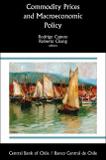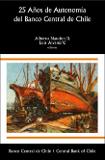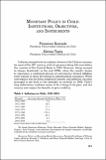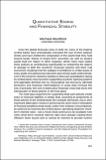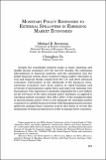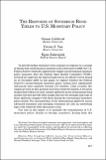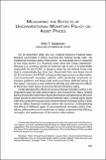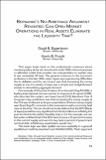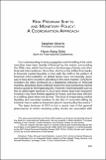Search
Now showing items 51-60 of 132
Monetary policy through asset markets: lessons from unconventional measures and implications for an integrated world
The global financial crisis of 2008 and its aftermath brought many new challenges for the world’s central banks. These new challenges have resulted, in turn, in bold experimentation—not just the vigorous application of traditional policy tools, but the use of new ones, or at least ones that were rarely ...
Commodity prices and macroeconomic policy
The Book Series on “Central Banking, Analysis, and Economic Policies” of the Central Bank of Chile publishes new research on central banking and economics in general, with special emphasis on issues and fields that are relevant to economic policies in developing economies. The volumes are published ...
25 años de autonomía del Banco Central de Chile
La historia monetaria de Chile, como la de la mayoría de los países de la región, contiene una larga lista de intentos fallidos por lograr la estabilidad de la inflación, intentos que solo se lograron superar a partir de la década de los noventa de la mano de un cambio institucional radical: entregar ...
Monetary policy in Chile: institutions objectives and instruments
Inflation seemed to be an endemic disease of the Chilean economy for most of the 20th century with its presence being felt even before the creation of the Central Bank in 1925. However things seemed to change drastically in the mid 1990s when the country began to experience a sustained process of ...
Quantitative easing and financial stability
Since the global financial crisis of 2008–09 many of the leading central banks have dramatically increased the size of their balance sheets and have shifted the composition of the assets that they hold toward larger shares of longer-term securities (as well as toward assets that are riskier in other ...
Monetary policy responses to external spillovers in emerging market economies
Despite the remarkable progress made in many emerging and middle-income economies over the last few decades the continuing liberalization in financial markets and the integration into the global financial system these countries remain highly vulnerable to real and financial shocks coming from the U.S. ...
The response of sovereign bonds yields to U.S. monetary policy
To provide further stimulus to the economy in response to a cascade of shocks that roiled financial markets in the latter part of 2008 the U.S. Federal Reserve started to aggressively employ unconventional monetary policy measures after the Federal Open Market Committee (FOMC) lowered the target for ...
Measuring the effects of unconventional monetary policy on asset prices
On 16 December 2008 the U.S. Federal Reserve’s Federal Open Market Committee (FOMC) lowered the federal funds rate—its traditional monetary policy instrument—to essentially zero in response to the most severe U.S. financial crisis since the Great Depression. Because U.S. currency carries an interest ...
Bernanke's no-arbitrage argument revisited: can open market operations in real assets eliminate the liquidity trap?
This paper looks back on the professional consensus about monetary policy at the zero bound prior to the 2008 crisis and proposes a calibrated model that provides one interpretation to explain why it was somewhat off base. The general consensus in the economics profession in the late 1990s when Japan ...
Risk premium shifts and monetary policy: a coordination approach
Our understanding of crisis propagation and the telling of the crisis narrative have been heavily influenced by the events surrounding the 2008 crisis which has focused on the leverage of banks and other financial intermediaries. Since then the focus has shifted from banks to financial market liquidity ...


